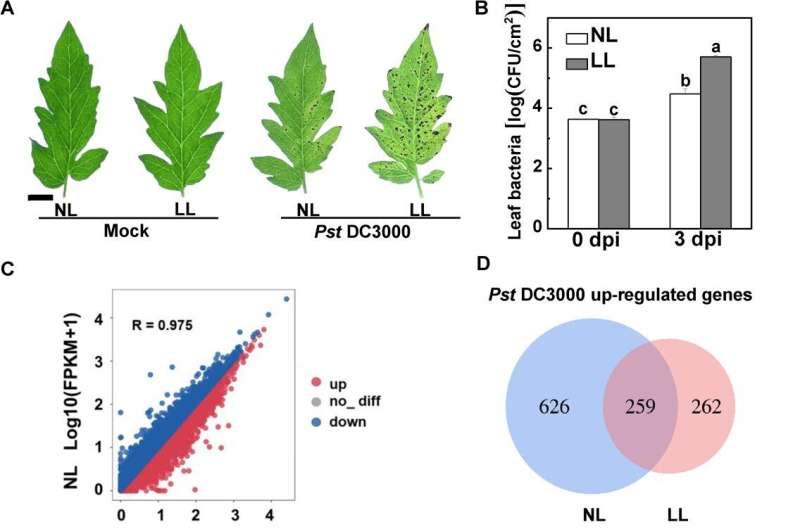This article has been reviewed according to Science X's editorial process and policies. Editors have highlighted the following attributes while ensuring the content's credibility:
fact-checked
proofread
Shedding light on shadows: Unveiling the impact of low light on tomato disease susceptibility and defense mechanisms

The global challenge of plant disease outbreaks under low light intensities leads to significant crop yield losses, with the mechanisms of low light's impact on plant defense poorly understood. Research has identified high light conditions as enhancing plant defense through reactive oxygen species (ROS) bursts, yet the role of ROS under low light remains ambiguous, showing both potential damage and unclear effects on disease resistance.
This gap in understanding, especially in critical crops like tomatoes susceptible to diseases in low light, highlights the urgent need for research into the molecular mechanisms of plant defense responses in varying light conditions.
In August 2023, Horticulture Research published research on this topic titled "Transcriptomic and genetic approaches reveal that low-light-induced disease susceptibility is related to cellular oxidative stress in tomato."
Utilizing RNA-seq analysis, this study explored the susceptibility of tomato plants to Pseudomonas syringae pv. tomato DC3000 (Pst DC3000) under varying light intensities, focusing on the oxidation-reduction process and its effects on reactive oxygen species (ROS) accumulation and protein oxidation. The research revealed that under low light, tomato plants exhibited increased disease severity and bacterial populations due to exacerbated ROS accumulation and protein oxidation, compared to normal light conditions.
Further gene expression and enzyme activity analyses showed that the defense responses, particularly involving ascorbate peroxidase 2 (APX2) and other antioxidant enzymes, were significantly induced under normal light but remained unresponsive under low light. This was alongside a decreased ascorbate to dehydroascorbate (AsA/DHA) ratio under low light, indicating impaired cellular redox homeostasis.
The study also highlighted that the antioxidant system's effectiveness is compromised under low light, with significant downregulation of genes related to antioxidant enzymes following Pst DC3000 inoculation. This was corroborated by quantification of enzyme activities and AsA/DHA ratios, which further confirmed the oxidative stress aggravation under low light. Notably, APX2 mutants, created using CRISPR-Cas9 gene editing, showed heightened susceptibility to Pst DC3000 under low light, a condition that was mitigated by exogenous AsA treatment, underscoring the critical role of APX2 in plant defense, particularly under stress conditions of low light.
In conclusion, this study combining RNA-seq with enzymatic activity assessments and genetic manipulation via CRISPR-Cas9 elucidates the intricate relationship among light intensity, oxidative stress, and plant defense mechanisms. It underscores the importance of maintaining cellular redox homeostasis for plant resistance, particularly under low light conditions, offering insights into potential crop protection strategies against pathogen-induced oxidative stress.
More information: Qian Luo et al, Transcriptomic and genetic approaches reveal that low-light-induced disease susceptibility is related to cellular oxidative stress in tomato, Horticulture Research (2023). DOI: 10.1093/hr/uhad173
Provided by BioDesign Research





















